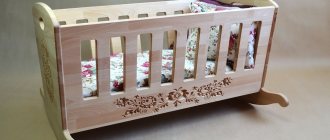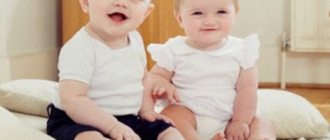Why does a baby like to jump when he is held by the arms? Because his whole body is preparing to stand on its feet. While the baby cannot yet stand on his own, the body muscles are trained during such a children's dance. When does a child begin to stand on his own? Let's learn about this from the article.
Opinion of E. Komarovsky
A well-known doctor claims that every child sooner or later has a desire to stand and the role of parents in mastering this skill is only to facilitate and secure the process. A child learning to stand does not need to wear shoes; let the baby learn this barefoot.
Many parents proudly declare that their baby stood up independently at 4,5,6 months, and began walking at 8,9,10. In this regard, Komarovsky wants to focus attention on the fact that due to early long-term load on the spine, such children may have a variety of problems in the future - curvatures, radiculitis and others.
The child himself must want to stand and before the age of six months there is no need to train and teach him to stand. There is no problem that the child will lie and crawl for another one or two months.
Expert advice
None of the specialists who monitor a newborn from the first days of his life can say with accuracy how many months he can be put on his feet. Some parents are convinced that after the first month of life the baby can’t be placed on the surface with full emphasis, but is this true? The answer to the question is quite simple, each child will begin to make independent attempts when his spine is ready to accept the appropriate loads, so we strongly recommend that you do not rush your child into this.
Orthopedists, as a rule, draw the attention of parents to the fact that if you rush things, this can lead to deformation of not only the foot, but also the spine, which in the future can have a very detrimental effect on the health of the newborn. Average indicators indicate that a baby can be delivered already in the tenth month of the baby’s life. At this stage of development, his joints and spine, which are responsible for the movement of his legs, are able to withstand the load.
If a child has been diagnosed with a disease - rickets, then all attempts to stand on their own legs should be very limited, since in the future this can lead to curvature of the legs. As for muscle hypertonicity, in this case the child will try to sit down earlier rather than sit. Due to excess stress on the feet, they may become deformed, and therefore the child should not stand for a long time.
Should I be forced to stand on my feet?
The task of parents is only to encourage the physical development of the baby. Forcing a child to do something before he is ready for it (both sitting and standing) is a huge mistake that can not improve, but, on the contrary, worsen his physical condition. Encourage your baby to crawl, but the baby should learn to sit and stand on his own.
Role of parents
What parents should do:
- Encourage crawling as it strengthens the muscles and spine.
- Do exercises in a playful way, developing the baby’s muscles.
- Avoid vitamin D and calcium deficiency.
- Perform massage as this is the most beneficial muscle stimulation.
- Take frequent walks in the fresh air.
- Love and care, paying a lot of attention.
- Help, but don't rush.
Exercises to encourage standing
Many people believe that in order to be able to stand, the baby’s arm muscles must be well developed so that the baby can pull himself up and hold on to support. In reality, the most important muscles for mastering getting up and standing are the muscles of the hips, back and shoulders.
The following exercises will help develop these muscles, and therefore encourage getting up and standing:
- When your baby is already sitting confidently, you can start practicing with him on a not fully inflated fitball. Having placed the baby on the ball facing away from you, hold the child by the hips and begin to tilt him in different directions. Thanks to such training, the child will develop the ability to maintain balance.
- Place the child on the table facing away from you and have him squat. Holding the baby by the hips, begin to rock him back and forth a little, encouraging him to stand up on his even legs. If the child is not yet able to get up on his own, it means that the muscles of his legs are not yet strong enough.
- If the baby has already learned to stand up against a support, encourage more frequent use of this skill by attracting the baby with his favorite toy. Place the baby on the floor next to a sofa or chair, and place a toy on a hill. The child will become interested and want to reach for the toy, grab the support and stand up. At the first attempts, be sure to protect your baby from falling. And don’t forget to encourage your child in his successes.
How many months should a baby be delivered: massages and physical exercises for children under one year old
To date, a large number of different therapeutic massages and gymnastics complexes have been developed for children under one year old. In our article today we will look at several interesting manipulations for babies that young parents will need, by the way, if they want to raise a healthy and developed child.
- “Figure Eight” foot massage: the child lies on a flat surface, for example, a sofa and a changing table, the mother holds his foot with one hand, and with the fingers of the second she gently strokes his foot using the thumb with slight pressure, the remaining fingers clasp the foot. This manipulation can be supplemented by fingering the baby’s fingers.
- Exercise “Connecting unlike arms and legs”: the child should lie on his back, and at this time the mother should pull the elbow of her right hand to the knee of her left leg. A similar manipulation should be performed with the left arm and right leg. Thanks to this exercise, it is possible to strengthen not only the abdominal muscles, but also promotes good coordination.
Getting up early
A child may begin to try to stand up even before mastering the skill of sitting (before six months) if he has muscle hypertonicity. If such a baby is allowed to stand for a long time, deformation of the feet is possible. Distract the baby and do not allow a long vertical position, and also be sure to support him under the armpits.
We also advise you to read the article about when a child begins to stand. You will learn a lot of interesting things and be prepared for this interesting period in your child’s life.
Entry published by marfusha · June 23, 2014
2
Hi all. The child is 3.5 months old. One of the grandmothers) got into the habit of putting the child on his feet, like making him stomp. This activity brings her, as I noticed, a lot of pleasure. The child does not yet understand what they want from him. She holds him up by the armpits, but seems to force him to sit down so that there is support, then he begins to move his legs, placing his foot anyhow, of course.
The first time I caught her doing this activity, I thought that she had read a lot of literature, and decided to test the step reflex. The other day, while I was eating, she again stomped with him and laughed with him. I took the baby from her for feeding, but I was already thinking about the harmlessness of this process.
Our child was born with congenital torticollis, we are registered with an orthopedist, took a massage course, now I am doing gymnastics, as the masseuse advised, but we did not have any walking exercises, I just massage the feet from the inside so that the toes straighten.
In short, I am interested in information about whether it is possible to walk like this with a child, is it dangerous? We're going to see an orthopedist in a week, the masseuse has gone on vacation, the information on the Internet is twofold, some say it's impossible, some say it's even useful. I'm thinking about it. Maybe someone has links to read in more detail. Thank you.
Parents' attempts to speed up the baby's natural development process often lead to sad health consequences. First of all, this concerns early stimulation of walking. Let's figure out when you can put a child on his feet without harming him.
- Stages of physical development
- Child's readiness to walk
- Helping the baby stand up
- Komarovsky about the right age to stand on your feet
Too early or too late
Some babies begin to get up in their crib as early as 6 months or even a little earlier. Should I be concerned in this case? Most doctors believe that no - if the baby was able to stand up on his own, then his body is ready for such stress. Now your task will be to teach your child to land safely on his butt so that he does not fall backwards and get injured. At first, the little one will have to be secured and looked after almost all the time, but don’t worry - usually children quickly learn to sit up from a vertical position.
But if time passes and the baby does not try to rise to his feet, this may be a reason to consult a doctor. It is not a fact that the examination will reveal any serious problems - for example, plump, well-fed children have difficulty lifting their bodies, so it is more difficult for them to get up; they sit down later and begin to walk.
Also, many children, especially firstborns, may develop physically with a slight lag due to intrauterine hypoxia (oxygen starvation). This is also not a pathology; medications in such cases are used extremely rarely. The main “treatment” is gymnastics, swimming pool and special massage, which is done by nurses in the clinic. Sometimes one course of massage is enough for the child to sit down, stand up, or do something else that he could not do before.
Stages of physical development
The newborn spends the first few weeks of life in a horizontal position, the muscles are weak, and movements are not coordinated. By about 2–3 months, the baby can hold his head for a long time while lying on his stomach. From this moment on, the process of “verticalization” begins, that is, the gradual acquisition of the ability to stand and walk. It includes several stages:
- The ability to lift the upper body, leaning on outstretched arms and trying to reach an object of interest (4–5 months).
- Ability to crawl on the belly and sit (6-7 months).
- Active crawling on all fours (7–9 months).
- Successful attempts to rise to one's feet and walk with support (9–11 months).
- First confident steps (11–15 months).
Each stage is of great importance in the growing up of the baby; you cannot try to speed them up in any way. The formation of a muscle corset and the maturation of bone tissue takes some time. Experts categorically do not recommend putting babies of normal build before 9 months, and chubby babies before 10 months.
At an earlier age, weak back muscles and weak hip joints cannot cope with the load, resulting in the risk of the following problems:
- curvature of the lower limbs;
- pathologies of the hip and knee joints;
- foot deformity (flat foot, flatfoot);
- gross violations of posture and diseases of internal organs.
But a timely transition to a vertical position also carries the risk of harming the baby’s health. To prevent this from happening, you should not put the child on his feet for a long time and without additional support, or get carried away with walkers and other holding devices. It is better for parents to hold him by the armpits and place the child next to a reliable support (sofa, crib). It is advisable to leave the baby barefoot - he will quickly learn to maintain balance and control his body.
Sometimes the child independently tries to stand on his feet earlier than expected. In most cases, this happens due to hypertonicity of the muscles of the lower extremities. The pathology requires mandatory treatment; pediatricians usually prescribe special massage to patients. If the baby is healthy, there is no need to impose an absolute ban on attempts to get up, but it is advisable for parents to encourage crawling on all fours for a longer period of time.
Walkers and jumpers
Various types of jumpers and walkers are not recommended for use by children. As mentioned above, the child must learn to stand and walk independently, without the support of an adult. With the help of walkers, the child receives that freedom of movement that he is not yet able to achieve on his own. That's why children love to be in walkers. However, staying in them for a long time is not only not recommended, but prohibited!
Some parents believe that the sooner they put their child in a walker, the sooner he will learn to walk on his own. But in reality the opposite happens. Part of the child's weight is supported by the walkers themselves, which gives imaginary confidence that the child is ready to walk. In addition, walkers do not develop the vestibular apparatus and do not teach balance, without which walking is unthinkable. In a walker, the child leans forward to push off, but does not fall, thanks to the walker. When actually walking, the child will simply fall without receiving the usual support. Another problem that is inherent in walkers is foot support. To fully walk, the child must rest his entire foot on the surface. When using a walker, the baby often pushes off only with his fingertips, without ever learning how to position his foot correctly so as not to fall.
Editor's choice: How to choose the right blender for making cocktails?
To sum it up, walkers are completely useless as a walking trainer. However, they remain quite unsafe: a child can roll over in them and get injured. As entertainment, walkers can be used, but no more than 40-50 minutes a DAY! The only advantage that walkers can boast of is that they allow mom’s hands to rest.
https://youtu.be/dZz6pokdNj8
Child's readiness to walk
The pace of children's development varies significantly. Various factors influence the baby’s readiness to assume an upright position:
- Heredity. One or both parents started walking late or were overweight in infancy - you should not expect their child to stand on his feet early and take his first steps.
- Maturity of the nervous system. The baby’s movements must be clear and precise; the ability to maintain balance and grouping is required.
- General health. Any pathologies of internal organs, frequent colds and common allergies weaken the child and significantly delay development.
- Alternating physical and mental progress. Children develop in leaps and bounds, intellectual achievements are always replaced by physical ones. If the baby is actively learning to speak, most likely, during this period he will not begin to stand and walk.
- Motivation. The baby himself must want to stand on his feet, and if there is no such desire, the parents need to interest the baby: offer to get to their favorite toy on their own, show how other children walk. It is not worth forcing a child to get up and stand on his feet against his will.
Helping the baby stand up
To ensure that the baby is not lazy, gets to his feet in a timely manner and takes his first steps without harm to his health, parents should help him a little:
The first steps of a son or daughter are an achievement comparable only to the first manned flight into outer space. Every parent expects this, sometimes even too eagerly. But all children are different, and what is easy for some is difficult for others. Very often you can meet two peers, one of whom began to walk at the age of 9 months, but until the age of three he wants to say almost nothing. The other one, on the contrary, went late, but at two he was already chattering incessantly. Examples: the sea. And you need to find an individual approach to everyone.
Many young parents are interested in when they can put their baby on his feet. There is no definite answer here, but there are points that are important to know. Most specialists (pediatricians, orthopedists, etc.) believe that there is no need to rush nature. Indeed, the load on a fragile spine is fraught with unpleasant consequences. This should be especially taken into account if there is a vitamin D deficiency and the risk of developing rickets.
On the other hand, it would be nice if you encourage your baby’s attempts to sit and stand in every possible way. In a playful way, holding the child under your arms, you can squat and stomp. Light and fun exercises with breaks will only benefit the developing body. Crawling is also very important for the normal formation of the spine. Very often, doctors, checking innate reflexes, sit or stand very young children. This is normal, as this state lasts less than a minute.
Massage, walks in the fresh air, breastfeeding and the love of mom and dad will be very useful for general development and walking in particular. And the baby will gradually learn everything himself.
Noticed a mistake? Select it and press Ctrl+Enter to let us know.
First, we wait for the baby to start holding his head up, then for him to be able to roll over on his own, then for him to sit up and crawl, and finally for him to stand on his feet. All these, so to speak, development milestones are purely individual. Some people succeed early, others later. So it is impossible to establish any exact dates here.
Is your baby ready to stand on his feet?
Knowledge of some factors that determine when a child will be ready to change from a horizontal to a vertical position will help us answer this question.
Heredity
The resulting genes greatly influence the growth and character of the child. Remember yourself and your relatives at this age: if you and your parents are lively and active, then your child is unlikely to be prone to slowness and thoughtfulness, and vice versa. And if you began to crawl and walk early, then most likely your baby will sit up and walk early.
Physical build
It is much easier for slender children to get on their feet than for large and overweight children. The latter will do it later. But in no case can this be called a violation, it’s just that each child is individual, and the norm is a vague concept.
Nervous system development
The ability to maintain balance and control your arms and legs directly depends on this. So if a child has had or has neurological problems, he will begin to walk when the nervous system is ready for it. Everything is again purely individual.
Motivation
The child himself must want to stand on his own legs. The same as before - sit down or crawl. But if he doesn't do this, maybe he just doesn't want to yet. Get him interested! Motivation is important for kids. Place bright new toys not side by side, but at a distance - so that you can’t easily reach them. Maybe curiosity will force the baby to get up and take his first steps. Or maybe on a walk he will see how other children walk and want to follow their example. The main thing is not to force.
How do you know when a child is ready to walk and stand up?
1. All parents need to understand for themselves that each child is unique, and you should not look up to the children of neighbors and acquaintances. In the vast majority of cases, the baby begins to stand and walk at the same age as his parents.
2. The child is ready to stand up only if he has been sitting well for a long time and is crawling. He needs these motor skills to strengthen his bones and muscle corset, and develop a sense of balance. Therefore, answering the question - from how many months can a child stand on his feet? The answer will be no earlier than ten to nine months. It is by this age that these skills have already been formed in almost all children.
3. It is necessary to take into account the constitutional characteristics of a particular baby. It is easier for thin children to stand on their feet than for overweight children, since the former have less load on the joints of the legs and spine.
4. If the child had any birth injuries that resulted in defects in nervous development, then there is a high probability that the baby will later begin to develop his motor skills.
5. You need to start actively helping your child stand on his feet when he begins to stand on his own in the crib, leaning his hands on its ceiling.
Helping the baby
It turns out that everything depends on nature, but practically nothing depends on you and me? Not at all! We should not wait passively until the child is ready to stand up. On the contrary, we are obliged to promote the development of the baby’s muscular system.
Massage
Both massage and encouragement to active movement are suitable for this. For example, after bathing, do not rush to dress the baby, let him take air baths, and you will see how cheerfully and cheerfully he begins to jerk his arms and legs. Great exercise!
Crawl
It is also very important not to miss such an important stage in development as crawling (See “When a child begins to crawl”). Although many parents believe that it is not at all necessary to first learn to crawl and then stand on their feet, orthopedists are of a completely opposite opinion: crawling is necessary to strengthen both the spine and muscles. In general, it is important for a child to grow up in an atmosphere of love and care. Thanks to this, he will develop normally, showing interest in the world. And at some point he will want to explore it in a vertical position.
It is impossible to answer exactly at how many months the baby can be put on his feet. Doctors can indicate average periods and give general recommendations, but each child is individual.
When can you put your baby on his feet?
There is no need to rush through this process. If the child is healthy, he will definitely go, no matter if it happens at 10 months. or at 1.5 years. It's okay if he crawls or sits for a while longer.
When the baby leans on his legs, a huge load is placed on the spine. If the muscles are still weak, this can lead to curvature or other musculoskeletal problems.
A baby's readiness to walk can be determined by the following factors:
- Heredity. It is necessary to take into account when the parents went. Children usually repeat the exploits of mom and dad.
- Physical build. Thin children get on their feet faster than fat ones.
- Maturity of the nervous system. The ability to maintain balance in an upright position depends on the state of the central nervous system. Children with neurological disorders walk later than their healthy peers.
- Phases of development. Intellectual development alternates with physical development. Children are mentally developed and can stand on their feet later.
- Motivation. When a child understands that it is faster to get to a toy on two legs than on all fours, he will take the initiative.
It would be correct if the baby first learns to crawl, then sit up on his own, and then stand up. You cannot force it.
Answers to the most common questions
1) Is it possible to stand a one-month-old baby on his feet?
There is absolutely no need for this. At one month of age, the baby just begins to hold his head up well on his own. Accordingly, only his neck muscles have strengthened so far. The remaining back muscles are weak and undeveloped. The baby has no sense of balance, the bones of the pelvis and feet are soft. They are not yet adapted to bear their own weight in a vertical position. Such early forced lifting will eventually lead to the child developing flat feet, scoliosis of the thoracic and lumbar spine, and deformation of the hip joints.
Only a pediatrician can put a child on his feet holding him by the armpits when checking the child’s innate reflexes. Until about three months, the child has an unconditioned walking reflex. When the child is lifted vertically and placed on his feet, he begins to take small steps. This is an indicator of the normal development of the child’s nervous system, and not his readiness to stand and walk independently in the near future.
2) Is there a difference when to raise a child based on gender?
There is absolutely no difference. You can put a girl on the legs of a child and put a boy on the legs of a boy at the same age. When a baby begins to stand or walk independently does not depend on gender, but only on his physical development and heredity, which he inherited from his parents. If they began to stand and walk after a year, then it is foolish to expect that their child will walk at ten months.
3) When can I put my child on his feet with support on a walker?
You can put a child on a walker only when he begins to rise independently in the crib and confidently holds on while standing by his parents’ hands. This happens no earlier than the tenth to eleventh month of life. Walkers are good because the child will not fall in them, but many European and domestic pediatricians believe that they additionally load the child’s spine and legs. Therefore, it is not recommended to stay in them for more than two hours a day.
At what months should a baby with health problems be supported on his legs?
A child with muscle hypertonicity may try to stand up at six months, before learning to sit. This cannot be allowed. Distract your baby by any means so that he sits down or lies down. Staying in a vertical position for a long time will lead to deformation of the feet.
You can put your baby on his feet starting from 10 months. Until this time, be sure to support him under his armpits so that his feet barely touch the surface.
Encourage crawling, it strengthens the spinal muscles.
If a child has rickets, try to limit the baby’s attempts to lean on his legs for longer. Previously 10 months You definitely can’t get up, otherwise your limbs will become twisted. Take your child for walks in the fresh air more often, give him calcium complexes with vitamin D and give him a massage.
What time to stand on your feet should be decided by the child, not the parents. If you do not want to harm your baby, you should not forcefully teach and train him until he is ready for this.
Do you need a walker?
Sometimes mothers specifically buy this device precisely so that the baby spends more time in an upright position and begins to get up and walk faster. Unfortunately, this strategy works exactly the opposite - when moving in a walker, completely different muscles are used that are responsible for the correct position of the baby’s body when he gets up and walks independently. And if a child constantly runs around in a walker, he may begin to get up significantly later than his peers who are not specifically “verticalized.”
Comments
- Top
- All comments
- about the project
- Contacts
- Media kit
- Terms of use
- Terms of competitions
“Network publication “Woman’sDay.ru (Woman’sDey.ru)” Certificate of registration of mass media EL No. FS77-67790, issued by the Federal Service for Supervision of Communications, Information Technologies and Mass Communications (Roskomnadzor) December 13, 2021 16+.
Founder: limited liability company "Hirst Shkulev Publishing"
Editor-in-Chief: Dudina Victoria Zhorzhevna
Copyright (c) Hirst Shkulev Publishing LLC, 2021.
Any reproduction of site materials without the permission of the editors is prohibited.
Contact information for government agencies (including Roskomnadzor):
How many months can you put your baby on his feet and how to do it?
Many parents want to know at what age they can put their baby on his feet. It is impossible to give an exact answer, but there are points that you need to know. Many experts argue that nature itself should not be rushed. Indeed, you should not load the spine, otherwise it will lead to consequences. This must be remembered if the baby has a vitamin D deficiency. However, it will be good if the baby’s attempts to stand up or sit down are encouraged. Through play, fun and easy exercise will benefit your growing body. Crawling is very important for the development of the spine. Massage, breastfeeding, walks in the fresh air and love between mom and dad are very beneficial for the full development of the baby. And then the baby will begin to learn on his own.
Many orthopedists warn parents that they can only put their baby on his feet after 10 months, after the hip joint and spine have become stronger, so that skeletal deformities do not occur.
Other doctors talk about the first attempts to stand starting at birth, using stepping reflexes that begin to disappear after 3 months. We must not forget that we must always take into account the developmental characteristics of the child’s entire body. There are so many doctors, so many opinions, especially about when a child can be put on his feet.
With rickets, it is necessary to limit the child’s attempts to stand up due to curvature of the legs. Vitamin deficiency. D and calcium can lead to negative consequences, curvature of the spine and lower extremities. And the game form will only help stimulate attempts to get up.
With hypertonicity of the baby's muscles, children make attempts to stand up before six months, until they begin to sit independently. The baby’s foot experiences a lot of stress due to the baby’s weight and muscle tension, and as a result it can become deformed. When a baby stands on tiptoes, he gets tired quickly. In such a situation, it is necessary to distract the baby, while supporting the child under the arms and not allowing him to remain in an upright position for a long time.
During the massage, the doctor often moves the baby and puts him on his feet for a while, in this way he checks the innate reflexes. There is no harm in this. In addition, massage stimulates the formation of new abilities and skills and the physical development of children.
In any case, you should not force your baby to get up, but only support and help him. The main thing is to create a supportive and loving atmosphere for your baby. Then your child will be able to develop correctly.
The first hesitant step is a great joy for parents and, naturally, a real success for the little winner. Everyone is looking forward to this moment with great impatience. But we should not forget that development in children occurs in different ways - some babies confidently stomp already at nine months, while others have not even tried to learn to stand at one year old.
If you deliver your baby too early, it can lead to problems with the spine
- Do we need to rush?
- Is your baby ready for such a load?
- When can a child be put on his feet? video
Training walking
How many months should you start doing gymnastics with elements of standing up and can a one-month-old baby be subjected to such stress? You can and should do gymnastics with your child from birth!
Editor's choice: How to choose a nanny for a child: basic rules
In children in the first month of life, “reflex walking” can be observed. If you take the child under the arms, supporting his weight and tilt him slightly forward, the baby will begin to reflexively move his legs, as if he were walking. At the same time, it is important to control that the child only lightly touches the surface, and that the main weight falls on the parents’ hands. To understand how this exercise is performed, watch the video.
Regularly performing this exercise will subsequently allow you to quickly master walking skills. However, it is important not to waste time here. Reflex walking, if not practiced, disappears in a child by 2-3 months.
For the harmonious development of your child, practice the following exercises:
- Reflex walking;
- Laying on the tummy;
- Reflex crawling;
- Reflex extension of the spine;
- Fitball exercises, etc.
Do we need to rush?
All parents want to know: when can a child be put on his feet? In fact, there is no answer to this question, since you can only indicate the points that you need to know. Many experts believe that due to early stress on the spine there can be various negative consequences.
Despite this, the baby’s independent attempts to sit down or stand on his feet should be encouraged in every possible way. Massage, walks in the fresh air, breastfeeding and, naturally, the love of parents are invariably useful for the development of a child - all this contributes to the desire to start learning independently.
As for orthopedists, their opinion is divided. Some say that a child can be put on his feet no earlier than ten months, since at this age the spine and hip joint are already well strengthened and there is no need to worry about skeletal deformation.
Others are confident that the first attempts to stand can be made almost from the age of three months, since at this time the baby still has step-by-step reflexes.
Often, with hypertonicity, a baby may try to get up before he turns six months old. You should not rejoice at such too early development of your baby, since at this time the body is simply not ready for this - deformation of the foot is possible due to a very heavy load. In addition, standing at this age is very early; the child gets tired quickly and begins to stand on tiptoe. Parents can be advised to distract the baby from standing in every possible way, not to allow him to remain in this position for too long, and even better, to support the little one under the armpits.
At the same time, independent attempts to rise must be encouraged.
And ours is already walking...
You can often hear from parents how proud they are that their child sat down or started walking earlier than expected. Famous children's pediatrician Komarovsky E.O. warns - you should not help your child master these skills, so as not to harm his health in the future!
Editor's choice: How to protect a child if the mother is sick - rules
The vertical position of the body puts a large load not only on fragile legs, but also on the pelvic bones and spine. Therefore, the longer the child has a crawling period, the better for strengthening the spine and legs.
Nature designed it in such a way that until the child’s body is ready for such loads, he will not be able to sit or stand on his own. But with the help of their parents, children are happy to stand at the support or sit. However, despite the child’s joy, his muscles are not yet ready to support the weight of his body, and such a load can deform fragile bones and add back problems in adulthood.
Is your baby ready for such a load?
Doctors note that the baby’s readiness to stand depends on the following factors.
- Genetics. Remember that thoughtfulness and a phlegmatic mood are already traits of a future character: after all, some are naturally lively, while others are thoughtful and balanced. It makes sense to analyze the family pedigree. If the baby’s parents were large children, and, moreover, rather slow, then their baby is unlikely to be too playful. But there is a chance that he will get on his feet later than other children and will move slowly.
- Physical development. There is no child who develops according to the table proposed by pediatricians, because they offer an average option. Large and plump babies need more time to get on their feet, but small and puny babies can do this much easier and faster. If your baby is too inactive and lazy, ask your pediatrician to prescribe you a massage and special exercises - this has never harmed anyone.
- "Verticalization". To stand, the baby must learn to maintain balance and control his limbs. All this is very difficult - from the point of view of the nervous system. Kids get used to it gradually. First, the baby looks at objects, then he begins to touch them. At first the baby will try to sit up, then crawl, and only after that will stand on his feet. If your child has and has had neurological problems, then this may delay the process of walking for some time - do not worry, this will happen as soon as the nervous system matures.
- Phase rotation. The period of physical growth and intellectual development always alternate with each other. It's quite normal. In the case when a child, as they say, “takes a break,” do not rush him - you should not force him to do something.
- Wish. Does your baby have a desire to stand? It is possible that the child lacks motivation to start walking. It is very important for him to see other children who have already gone, or interesting things that he cannot reach himself, so he needs to get up.
Baby's readiness to stand on his feet
On average, parents should focus on the child’s age and not try to help him get on his feet before the ninth month of life. But not all children develop at the same speed; some are ready to get up a little earlier, others a little later.
Signs of readiness
When determining signs of readiness, the following factors must be considered:
- Genetic. When one of the parents got to his feet too early or, conversely, too late, one should expect the same from the baby. In addition, increased baby weight also slightly slows down the baby's willingness to stand;
- Presence of common diseases. Congenital or acquired pathologies, viral infectious diseases always affect the development of the child. Such kids get up later;
- Cyclicity of physical and mental development. In the development of a child, changes occur in leaps and bounds, slowly accumulating. When the baby makes progress in pronouncing the first words, is captivated by toys, that is, engaged in intellectual activity, he may give up trying to get up for a while and generally moves less. Then, on the contrary, a period of increased physical activity begins;
- Motivation. It lies in the baby’s desire to stand on his own legs. To do this, you can interest him by placing the toy out of reach so that the baby will need to make some additional movements to get it.
Important! For some diseases (for example, juvenile arthritis), parents should not decide to have their child diagnosed on their own without consulting a specialist.
Difference for girls and boys
There is no clear opinion here. Most experts say that there is no difference, it all depends on the physical condition of the baby. Others advise placing a girl a little later than a boy, on average by 1 month.
The age of the child standing on his feet
If parents notice the readiness, and most importantly, the great desire of the baby to stand up, then they often think: is it too early, at what months does a healthy child stand on his feet without the threat of harming his proper development, and when is the time to help him?
There is no need to suppress the baby’s activity and constantly put him down or sit him down when he tries to get up. It will be enough for the parents themselves to get rid of attempts to install it. He still won't be able to stay on his feet for long.
When the child has reached about 8 months, sometimes earlier, and shows a frequent desire to stand, the parents’ task is to support him with his armpits, trying to avoid prolonged stress on the child’s legs and spine.
When can a child be put on his feet? video
If a baby tries to get up before six months, this indicates muscle hypertonicity.
Don't force your baby to stand - create a better atmosphere for independent attempts
First, it probably needs to be said that there is no specific age when you can put a child on his feet. There are restrictions for early periods - no younger than 7-8 months. However, only the baby can show that he is ready, this will manifest itself in his attempt to maintain balance and stand on his feet with the support of his hands. This natural stage of development just says that it is already possible. The nuances of this period of the baby’s life:
Preparation and training
No, no, the child, of course, does not need special classes to strengthen his muscles - Nature itself made sure that the baby constantly improves his motor skills. And only in cases where some problems or deviations are observed, the help of doctors and exercise therapy instructors may be required.
Before standing up, any child trains for a long time, learns to control his arms and legs, improves coordination of movements, and develops muscles. Staying upright is not an easy task; you usually have to learn to crawl and sit up first. If the baby is already sitting, this indicates that the muscles of his back are sufficiently strengthened and are able to hold the body in an upright position. And the mastered crawling skill indicates that the child has fully learned to control his body and make several movements at once in a certain direction.
As a rule, a baby learns to stand up against a support by clinging to something - the bars of the crib, furniture, as well as... bedspreads, wires and other not entirely safe things. When you notice that the child is stretching and wants to get up, immediately remove from his reach anything that could pose a danger to the baby. Now is the time to equip the crib with protective sides, since at first, after learning to stand up, the baby may fall back and hit his head.
What time can you put your baby on his feet?
It is generally accepted that the initial setting of a child on his legs can begin after he independently learns to sit, maintaining balance and firmly orienting his head. Sometimes there are “crazy people” who learn to walk before sitting or crawling, but this is rather an exception or a developmental pathology.
It is worth keeping in mind the differences between girls and boys, because the main load when walking falls on the hip joint and spine. Girls need to sit down and stand on their feet a month later than boys.
An important criterion for the decision to get a baby back on his feet is his physical condition and the degree of physiological development.
With a normal general condition, children place their legs differently, plunging mothers into confusion.
The child places his foot incorrectly
Many parents notice that the baby places his leg incorrectly: inward, crooked, bending his toes, on a rib or toe. Let's figure out why this happens and whether something needs to be done.
Initially, children's legs in 98.6% of cases have a characteristic “O” shape, with the feet often turned toes towards each other. Sometimes this can be accompanied by classic clubfoot, when the foot stands on the outside - all this is quite natural and normal.
During the very first attempts to stand on his feet, he often curls his toes - this is a reflex reaction to an irritant (floor, flooring) - this is a normal phenomenon that goes away after 1-2 weeks of regular exercise. If the child has not stopped curling his fingers, you should go to the clinic and take a referral to a dermatologist and orthopedist (it’s never a bad idea to get checked).
Often children (especially girls) put their feet on their toes - this is an example of psychosomatic imitation and the desire to grow, becoming taller. That is, it is not just natural, but absolutely normal. In this particular case, anxiety may be caused more likely by the absolutely correct positioning of the legs without the manifestation of all the listed imitations and reflexes.
You should be wary if non-standard positioning of the legs continues for more than 3 weeks (subject to regular exercise) or occurs asymmetrically (in itself not scary, but may be a sign of the onset of development of flat feet or club feet).
If this does not happen constantly, but systematically, then this is a clear sign of the severity of the development of one side (right-handed or left-handed).
Cautions
Why you can’t put your baby on his feet early:
- Early placement can lead to curvature of the legs, because the bones are still soft, as well as to excessive activity of the sweat glands (the legs will constantly sweat, which will lead to a characteristic odor and many fungal diseases).
- Late onset is dangerous due to the formation of pathological gait and foot placement. To avoid this, you should use a studded rubber mat and several exercises that any pediatrician or pediatric orthopedist will show you.
- Treatment for congenital pathologies or acquired diseases (juvenile arthritis, for example) should be supervised by an experienced orthopedist. Do not under any circumstances try to position your baby yourself.
So mothers of two-month, three-month and even six-month babies, don’t rush. Your baby will get up when the time comes.










